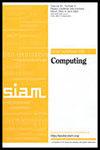Sampling Graphs without Forbidden Subgraphs and Unbalanced Expanders with Negligible Error
IF 1.6
3区 计算机科学
Q3 COMPUTER SCIENCE, THEORY & METHODS
引用次数: 0
Abstract
Suppose that you wish to sample a random graph over vertices and edges conditioned on the event that does not contain a “small” -size graph (e.g., clique) as a subgraph. Assuming that most such graphs are -free, the problem can be solved by a simple rejected-sampling algorithm (that tests for -cliques) with an expected running time of . Is it possible to solve the problem in a running time that does not grow polynomially with ? In this paper, we introduce the general problem of sampling a “random looking” graph with a given edge density that avoids some arbitrary predefined -size subgraph . As our main result, we show that the problem is solvable with respect to some specially crafted -wise independent distribution over graphs. That is, we design a sampling algorithm for -wise independent graphs that supports efficient testing for subgraph-freeness in time , where is a function of and the constant in the exponent is independent of . Our solution extends to the case where both and are -uniform hypergraphs. We use these algorithms to obtain the first probabilistic construction of constant-degree polynomially unbalanced expander graphs whose failure probability is negligible in (i.e., ). In particular, given constants , we output a bipartite graph that has left nodes and right nodes with right-degree of so that any right set of size at most expands by factor of . This result is extended to the setting of unique expansion as well. We observe that such a negligible-error construction can be employed in many useful settings and present applications in coding theory (batch codes and low-density parity-check codes), pseudorandomness (low-bias generators and randomness extractors), and cryptography. Notably, we show that our constructions yield a collection of polynomial-stretch locally computable cryptographic pseudorandom generators based on Goldreich’s one-wayness assumption resolving a central open problem in the area of parallel-time cryptography (e.g., Applebaum, Ishai, and Kushilevitz [SIAM J. Comput., 36 (2006), pp. 845–888] and Ishai et al. [Proceedings of the 40th Annual ACM Symposium on Theory of Computing, ACM, 2008, pp. 433–442]).无禁止子图的采样图与误差可忽略的非平衡展开器
假设您希望对一个随机图进行采样,该图的顶点和边取决于不包含“小”尺寸图(例如,clique)作为子图的事件。假设大多数这样的图是自由的,这个问题可以通过一个简单的拒绝抽样算法(测试-cliques)来解决,其预期运行时间为。是否有可能在一个运行时间内解决这个问题,而不是多项式地增长?在本文中,我们介绍了一个具有给定边缘密度的“随机看起来”图的一般采样问题,该问题避免了一些任意预定义大小的子图。作为我们的主要结果,我们证明了这个问题是可解决的,相对于一些特别设计的-智能独立分布在图上。也就是说,我们为-wise独立图设计了一种采样算法,该算法支持子图在时间上的自由度的有效测试,其中是的函数,指数中的常数是独立的。我们的解决方案扩展到两者都是-一致超图的情况。我们使用这些算法获得了失效概率在(即)中可以忽略的常次多项式不平衡展开图的第一个概率构造。特别地,在给定常数的情况下,我们输出一个二部图,其中左节点和右节点的右度为,使得任何大小的右集最多扩展为。这一结果也推广到唯一性展开的情况下。我们观察到,这种可忽略的误差结构可以在许多有用的设置中使用,并在编码理论(批码和低密度奇偶校验码),伪随机(低偏差生成器和随机提取器)和密码学中应用。值得注意的是,我们表明我们的构造产生了一组基于Goldreich的单向假设的多项式伸缩局部可计算密码伪随机生成器,解决了并行时间密码学领域的一个中心开放问题(例如,Applebaum, Ishai和Kushilevitz [SIAM J. Comput])。[第40届ACM计算理论研讨会论文集,ACM, 2008, pp. 433-442])。
本文章由计算机程序翻译,如有差异,请以英文原文为准。
求助全文
约1分钟内获得全文
求助全文
来源期刊

SIAM Journal on Computing
工程技术-计算机:理论方法
CiteScore
4.60
自引率
0.00%
发文量
68
审稿时长
6-12 weeks
期刊介绍:
The SIAM Journal on Computing aims to provide coverage of the most significant work going on in the mathematical and formal aspects of computer science and nonnumerical computing. Submissions must be clearly written and make a significant technical contribution. Topics include but are not limited to analysis and design of algorithms, algorithmic game theory, data structures, computational complexity, computational algebra, computational aspects of combinatorics and graph theory, computational biology, computational geometry, computational robotics, the mathematical aspects of programming languages, artificial intelligence, computational learning, databases, information retrieval, cryptography, networks, distributed computing, parallel algorithms, and computer architecture.
 求助内容:
求助内容: 应助结果提醒方式:
应助结果提醒方式:


